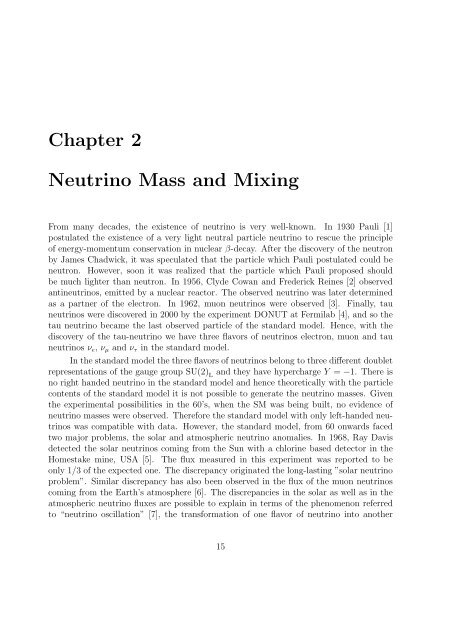PHYS08200604017 Manimala Mitra - Homi Bhabha National Institute
PHYS08200604017 Manimala Mitra - Homi Bhabha National Institute
PHYS08200604017 Manimala Mitra - Homi Bhabha National Institute
Create successful ePaper yourself
Turn your PDF publications into a flip-book with our unique Google optimized e-Paper software.
Chapter 2<br />
Neutrino Mass and Mixing<br />
From many decades, the existence of neutrino is very well-known. In 1930 Pauli [1]<br />
postulated the existence of a very light neutral particle neutrino to rescue the principle<br />
of energy-momentum conservation in nuclear β-decay. After the discovery of the neutron<br />
by James Chadwick, it was speculated that the particle which Pauli postulated could be<br />
neutron. However, soon it was realized that the particle which Pauli proposed should<br />
be much lighter than neutron. In 1956, Clyde Cowan and Frederick Reines [2] observed<br />
antineutrinos, emitted by a nuclear reactor. The observed neutrino was later determined<br />
as a partner of the electron. In 1962, muon neutrinos were observed [3]. Finally, tau<br />
neutrinos were discovered in 2000 by the experiment DONUT at Fermilab [4], and so the<br />
tau neutrino became the last observed particle of the standard model. Hence, with the<br />
discovery of the tau-neutrino we have three flavors of neutrinos electron, muon and tau<br />
neutrinos ν e , ν µ and ν τ in the standard model.<br />
In the standard model the three flavors of neutrinos belong to three different doublet<br />
representations of the gauge group SU(2) L<br />
and they have hypercharge Y = −1. There is<br />
no right handed neutrino in the standard model and hence theoretically with the particle<br />
contents of the standard model it is not possible to generate the neutrino masses. Given<br />
the experimental possibilities in the 60’s, when the SM was being built, no evidence of<br />
neutrino masses were observed. Therefore the standard model with only left-handed neutrinos<br />
was compatible with data. However, the standard model, from 60 onwards faced<br />
two major problems, the solar and atmospheric neutrino anomalies. In 1968, Ray Davis<br />
detected the solar neutrinos coming from the Sun with a chlorine based detector in the<br />
Homestake mine, USA [5]. The flux measured in this experiment was reported to be<br />
only 1/3 of the expected one. The discrepancy originated the long-lasting ”solar neutrino<br />
problem”. Similar discrepancy has also been observed in the flux of the muon neutrinos<br />
coming from the Earth’s atmosphere [6]. The discrepancies in the solar as well as in the<br />
atmospheric neutrino fluxes are possible to explain in terms of the phenomenon referred<br />
to “neutrino oscillation” [7], the transformation of one flavor of neutrino into another<br />
15
















